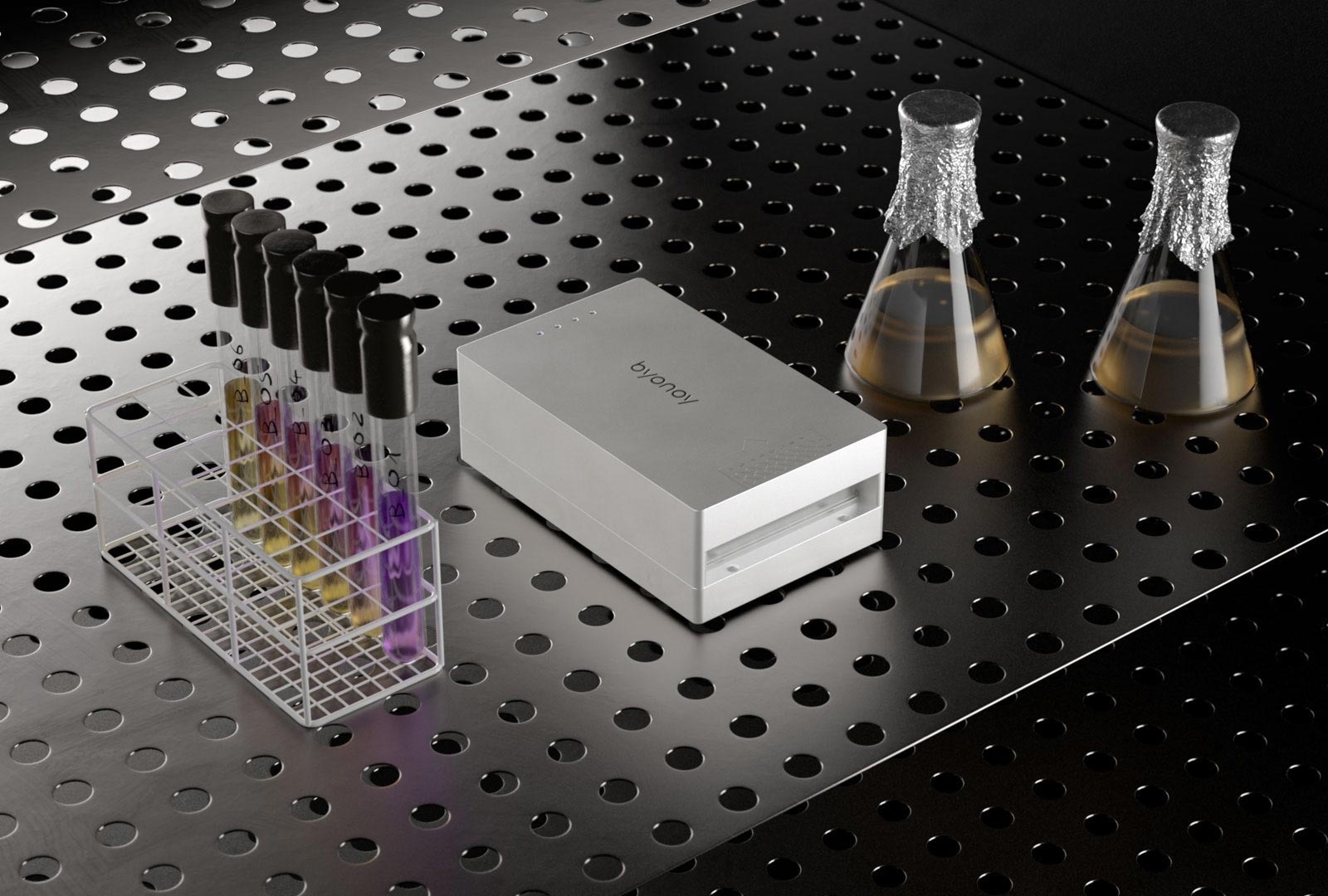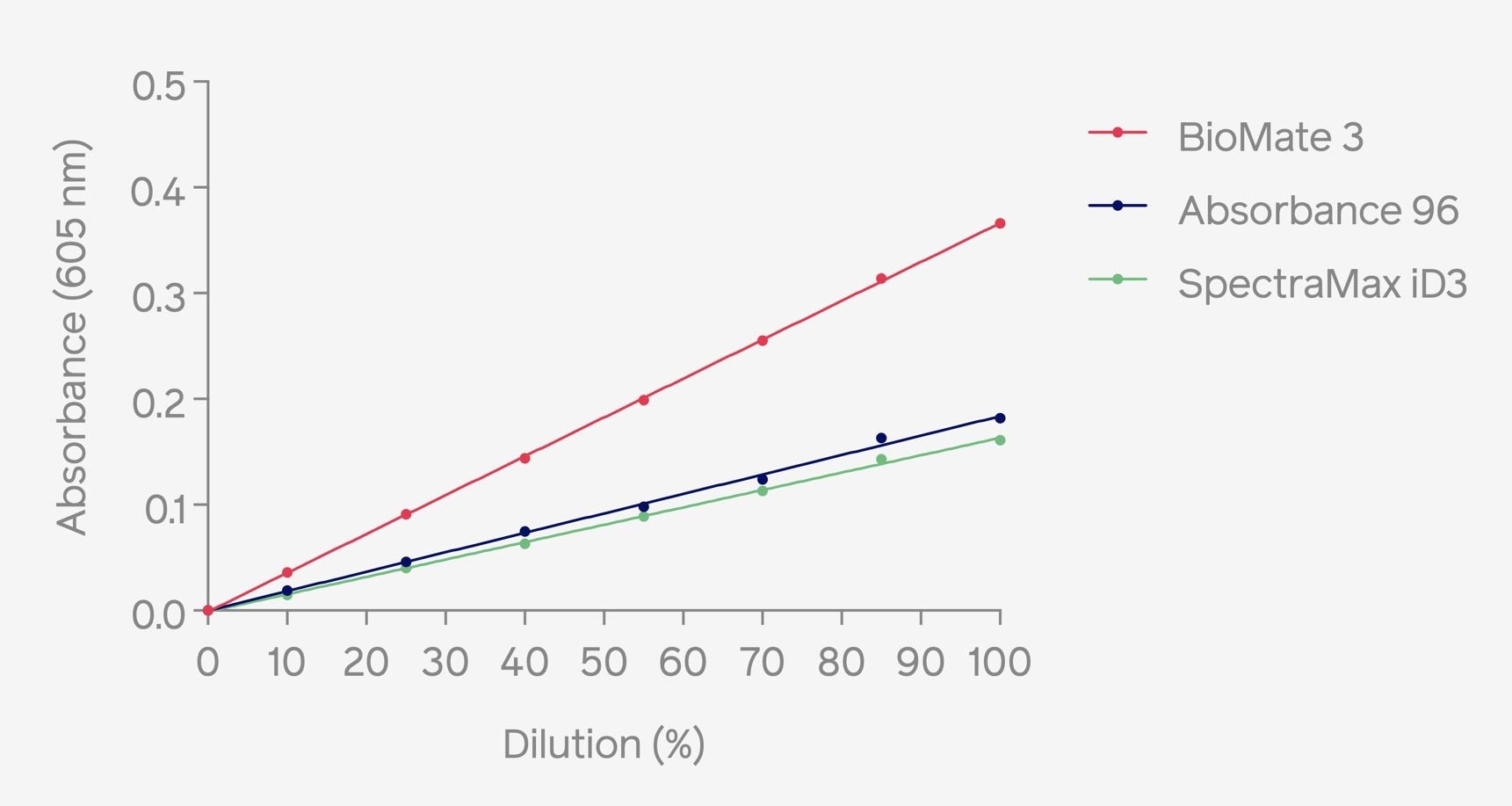Sponsored Content by ByonoyApr 19 2024Reviewed by Maria Osipova
The OD values acquired by Absorbance 96 were comparable to those derived from a different commercial plate reader. The data from Absorbance 96 confirmed its strength and dependability in obtaining OD600 measurements for bacterial growth assays. The Absorbance 96's compact design allows for the performance of flexible OD measurements and improves laboratory productivity and effectiveness.

Image Credit: Byonoy
Introduction
A vital component in many research fields is the ability to measure bacterial growth for fermentation, antibiotic effectiveness, synthetic biology, and food safety. Estimating bacterial growth improves the understanding of bacterial populations, their rate of growth and activity levels, and how environmental factors affect these processes.
Calculating the growth rate enables the optimization of conditions for bacterial expansion and maximizes the yield of metabolites and recombinant proteins required for biotechnological applications. In addition, examining the factors that influence bacterial growth allows targeted strategies for controlling and inhibiting bacterial expansion to be developed in particular pathogenic bacteria.
Many techniques are available for quantifying bacterial growth. Optical density (OD) measurement is the easiest and most conventional technique to calculate bacterial growth.
OD measurement relies on light scattering, where a beam of light (usually at 600 nm) is passed through a bacterial specimen. The more bacteria in a specimen, the more it will scatter the light. This technique is utilized to determine the bacteria count in a specimen. An increase in the bacteria count will also increase the OD600 value.1,2
This article details the Absorbance 96 plate reader’s ability to determine OD600 measurements. Working with HM Munich University of Applied Sciences, a comparative analysis of Absorbance 96 using a different spectrophotometer and microplate reader was conducted. The purpose was to observe the bacterial growth of a ureolytic bacterium Sporosarcina pasteurii, known for ts unique ability to microbially induce calcite precipitation (MICP) necessary for constructional engineering and material applications.3
The OD readouts acquired using the Absorbance 96 were compared to the readouts derived from other commercial plate readers. The data confirmed the efficiency and dependability of the Absorbance 96 for OD measurements.
The Absorbance 96 offers the significant advantage of a small footprint in comparison to conventional, large-size plate readers, providing mobility and improved workflows in the laboratory and notably in field applications.
Results
Absorbance 96 and SpectraMax iD3 plate readers produced comparable OD values
Bacterial growth is quantifiable by observing the optical densities of the specimens. To observe bacterial growth and compare the accuracy of their measurements, absorbance measurements utilizing the Absorbance 96 and SpectraMax iD3 microplate readers were completed.
Triplicate OD calculations of the dilution series of Sporosarcina pasteurii in a 96-well microplate were completed at 605 nm. The SpectraMax iD3 was first, then the same microplate was measured with the Absorbance 96. The achieved OD605 results from the two devices were comparable with insignificant differences in measurements (T-test: p-value > 0.005, (0.744)).
Two noteworthy conclusions were made based on the results. First, plate readers using comparable optical setups such as Absorbance 96 and SpectraMx iD3 are likely to produce comparable readout values. Second, the Absorbance 96, despite its compact size yielded results similar to the SpectraMax iD3. These results confirm that the Absorbance 96 achieves exceptional readout performance compared to conventional commercially available microplate readers.

Figure 1. Determination of OD605 measurements for different concentrations of Sporosarcina pasteurii performed on three different absorbance measurement devices. The graph shows the comparative analysis between a spectrophotometer (BioMate 3) and two different plate readers (Absorbance 96 and SpectraMax iD3). Image Credit: Byonoy
Photometer measurements recorded higher OD values
The optical density of the bacterial specimens at 605 nm with BioMate 3 photometer measured higher OD605 values in comparison to the values achieved by the plate readers (SpectraMax iD3 and Absorbance 96) (Fig. 1).
The variance in the absolute value of OD605 measured by the photometer is impacted by how the light beam passes through the specimen cuvettes horizontally in photometers with the path length of a standardized 1 cm.
In plate readers, the light beam passes through the wells vertically, creating variables that require consideration. In this scenario, the volume in the wells determines the path length.4.
Summary
A study of OD measurements achieved using the Absorbance 96 plate reader was compared to the BioMate 3 photometer and SpectraMax iD3 plate reader.
Due to the difference in the path length, BioMate 3 achieved higher OD605 values than both plate readers. The OD605 results achieved by Absorbance 96 and SpectraMax iD3 (plate readers) were similar, confirming that Absorbance 96 is capable of measuring bacterial growth as effectively as other plate readers.
When assessing the workflow for OD600 measurements, Absorbance 96 has a footprint advantage over other large traditional plate readers. Its compact size improves moveability, such as making on-site OD600 measurement at the workstation (e.g., fermenter) possible without requiring specimen transport to specific locations housing plate readers.
Materials and experimental outline
The efficiency of Absorbance 96 in measuring bacterial growth was evaluated using OD measurements for Sporosarcina pasteurii with different spectrophotometry devices. The readouts achieved were compared.
The bacterial culture of Sporosarcina pasteurii (obtained from German Collection of Microorganisms and Cell Cultures; DSMZ) was produced by cultivating it overnight in 20 mL of Caso medium (Merck 105458) augmented with 4 mL of urea (20 g/L) at 30 °C and 200 rpm.
The next day, the bacterial culture was diluted (1:10), and a series of dilutions (0%, 10%, 25%, 40%, 55%, 70%, 85%, 100%) of 10 mL were produced in a Caso medium.
For comparison, the first OD was measured with the BioMate 3 photometer (Thermo Fisher Scientific) at 605 nm (OD605) in triplicates by incubating 1 mL of the bacterial culture sample in semi-micro cuvettes (LabSolute).
The blank was established by setting it to 0%. Next, a 96-well microplate was incubated with the different dilution series specimens (above-mentioned). The OD was calculated by SpectraMax iD3 (Molecular Devices) microplate reader without a lid at 605 nm in triplicates.
The same 96-well microplate was then utilized (without shaking) to calculate OD with Absorbance 96.
References and further reading
- Mandelstam J, McQuillen K, Dawes, IW. Biochemistry of Bacterial Growth.1982, 449.
- Stevenson K, McVey AF, Clark IBN, Swain P. S, Pilizota, T. General Calibration of Microbial Growth in Microplate Readers. Sci. Reports 2016 61 2016, 6 (1), 1–7.
- Ma L, Pang AP, Luo Y, Lu X, Lin F. Beneficial factors for biomineralization by ureolytic bacterium Sporosarcina pasteurii. Microbe Cell Fact. 2020 Jan 23;19(1).
- Beer. Bestimmung der absorption des rothen lichts in farbigen flüssigkeiten. Ann. Phys. 1852, 162 (5), 78–88.
About Byonoy
The Byonoy GmbH was founded in 2015 as a spin-off from the University of Kiel and is situated in Hamburg. Our core competence is to develop innovative microplate readers based on photometric measurements for laboratory use.
Our aim is to facilitate the research and development process, to give researchers new opportunities, and to make the advantages of advanced biotechnological methods accessible to a broad range of laboratories.
For the realization of a successful innovation process our network is a crucial factor. Our partners help us to realize our ideas and we are glad to share our expertise with them.
Sponsored Content Policy: News-Medical.net publishes articles and related content that may be derived from sources where we have existing commercial relationships, provided such content adds value to the core editorial ethos of News-Medical.Net which is to educate and inform site visitors interested in medical research, science, medical devices and treatments.